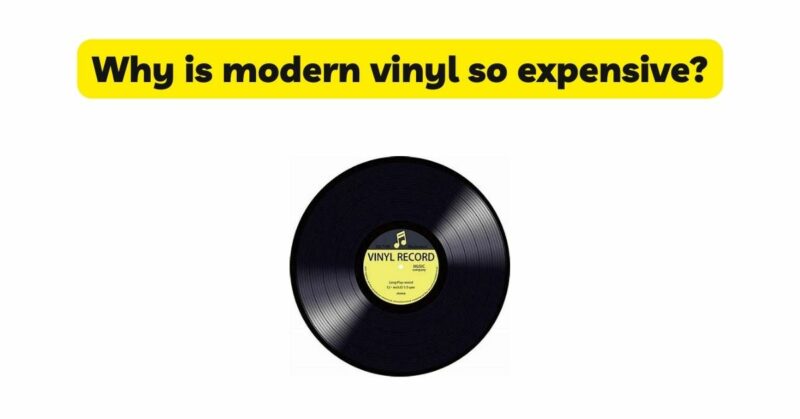As the resurgence of vinyl records continues, enthusiasts may find themselves wondering why modern vinyl often comes with a higher price tag compared to other music formats. The seemingly high cost of modern vinyl has sparked debates and discussions among music lovers. In this article, we will explore the factors that contribute to the expense of modern vinyl records, including production costs, market demand, quality considerations, and the value placed on the vinyl experience.
- Manufacturing Costs: The process of manufacturing vinyl records involves several intricate and labor-intensive steps, contributing to their higher cost. Unlike digital formats, which can be easily duplicated and distributed at a low cost, vinyl production requires specialized equipment, skilled labor, and quality control measures. The pressing of vinyl involves meticulous precision, from mastering the audio to creating the metal stampers, preparing the vinyl compound, and operating the pressing machines. These factors collectively increase the manufacturing costs associated with modern vinyl records.
- Limited Production Capacity: The resurgence of vinyl has resulted in increased demand, but the capacity of vinyl pressing plants remains limited. The number of pressing plants has not significantly expanded, creating a supply-demand imbalance. This scarcity drives up the cost of vinyl records as record labels and independent artists vie for limited manufacturing slots. The limited production capacity contributes to higher prices, particularly for smaller and independent releases that may have lower production runs.
- Premium Materials and Packaging: Many modern vinyl releases feature high-quality materials and elaborate packaging, adding to their production costs. Labels and artists often prioritize the aesthetic and tactile experience of vinyl, resulting in premium materials such as heavyweight vinyl, gatefold sleeves, and additional inserts. These design choices enhance the value and collectability of the vinyl release but also increase the overall cost of production, which is then passed on to the consumer.
- Quality Control and Audiophile Editions: Audiophile editions of vinyl records cater to discerning listeners who seek the highest possible sound quality. These releases often undergo additional quality control measures, including meticulous mastering, the use of premium vinyl compounds, and extensive testing to ensure optimal sound reproduction. The attention to detail and additional resources dedicated to achieving exceptional sound quality contribute to the higher price tag associated with audiophile editions.
- Market Demand and Consumer Expectations: The resurgence of vinyl records has led to a significant increase in market demand. Record labels and artists recognize this demand and often price their vinyl releases accordingly. Consumers’ willingness to pay a premium for vinyl, coupled with the perception of vinyl as a high-quality and collectible medium, influences the pricing strategy adopted by labels. The market demand and consumer expectations for vinyl as a unique and valuable music format play a significant role in driving up the prices of modern vinyl records.
- Licensing and Royalties: When it comes to reissues and special editions of older albums, licensing and royalty fees can significantly impact the cost of modern vinyl. Record labels must negotiate licensing agreements with the original rights holders, which often involves additional expenses. These costs are then factored into the pricing of vinyl reissues, making them relatively more expensive compared to digital or CD versions of the same albums.
- Economies of Scale: Vinyl production operates on economies of scale, meaning that larger production runs tend to lower the cost per unit. Smaller releases or limited editions with smaller production runs often have higher unit costs due to the absence of economies of scale. Additionally, independent artists or smaller labels may have higher production costs compared to larger, established labels, further contributing to the higher prices of some modern vinyl releases.
- Value of the Vinyl Experience: The vinyl experience encompasses more than just the music itself. Vinyl enthusiasts value the tactile and immersive nature of the format, the large album artwork, the ritual of handling and playing records, and the collectability factor. The perceived value of the vinyl experience influences consumers’ willingness to pay a higher price for vinyl records, as they see it as an investment in a unique and rewarding way of enjoying music.
Conclusion: The higher cost of modern vinyl records can be attributed to various factors, including manufacturing costs, limited production capacity, premium materials, quality control measures, market demand, and the perceived value of the vinyl experience. These factors collectively contribute to the overall expense of modern vinyl releases. Despite the higher price tag, many music enthusiasts and collectors find the tangible and immersive experience of vinyl records, along with the superior sound quality, well worth the investment. As the vinyl revival continues, the pricing dynamics of modern vinyl will continue to evolve, influenced by market forces and the changing demands of music lovers worldwide.


